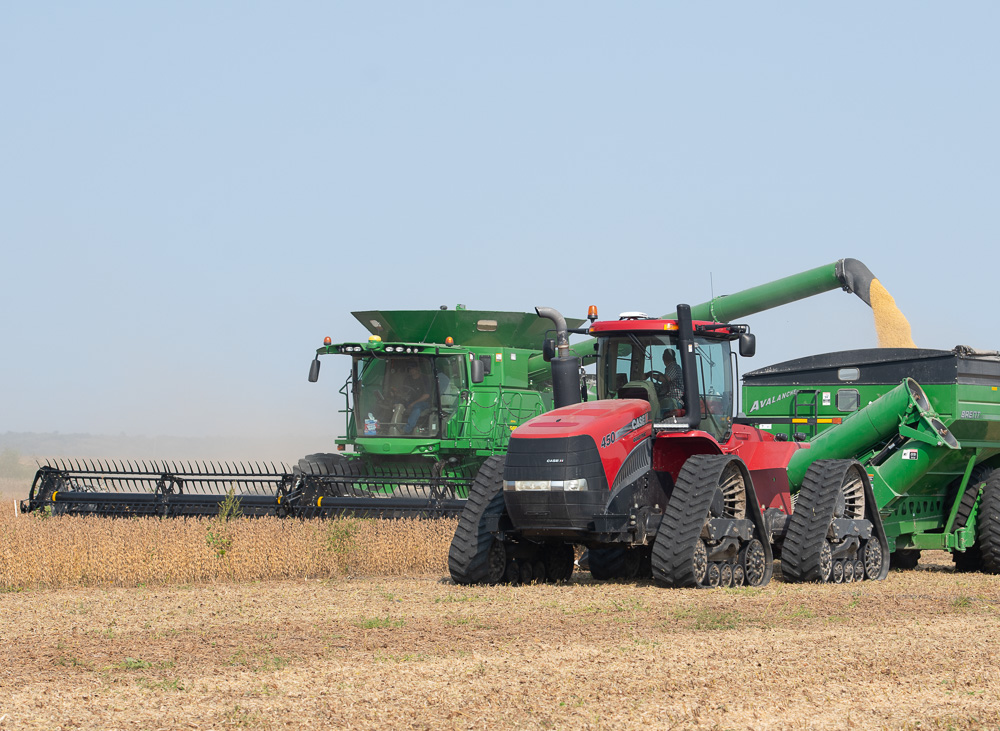
Jeff Jorgenson, ISA president, harvests soybeans earlier this week in one of his fields near the Missouri River in Fremont County. Jorgenson started the 2020 harvest in a field that last year was under several feet of water due to widespread flooding. Jorgenson was pleased with the yields considering the work that had to be accomplished to plant the field earlier this spring. (Photo: Joseph L. Murphy/Iowa Soybean Association)
Crop conditions and yields variable as harvest begins
September 24, 2020 | Bethany Baratta
Iowa farmers’ march—or trudge in some cases—through harvest began in earnest last week. Farmers report variability in crop conditions depending on field location and soil types. Some farmers are discovering the true impacts to crop quality and yields from the sustained drought and the Aug. 10 derecho.
“2020 has truly been the year of good, bad and ugly,” said Reed Burres.
He noted soybean field averages from 30 bushels per acre to mid-50-bushels per acre, well off typical years.
But 2020 has been anything but normal, he noted.
“During late June and all of July through August we couldn’t buy a good rain and I am expecting corn yields to reflect that,” he said.
He’s hoping for 190 bushels per acre on better soils. So far, corn yields with lighter soils have ranged anywhere from 80 to 220 bushels per acre in spots. Moisture and test weights have also been inconsistent.
As of Sept. 21, soybean harvest was 7% complete in the state, 17 days ahead of last year and 6 days ahead of average, according to the Iowa Crop Progress and Condition report released by the USDA National Agricultural Statistics Service (NASS).
Farmers in northwest and west central Iowa led the way with over 10% of their soybeans harvested, the NASS report said. Soybean condition rated 48% good to excellent.
ISA President Jeff Jorgensen says harvest in southwest Iowa is beginning slowly as farmers move farm to farm looking for fields fit for harvesting.
“Yields are variable to say the least,” Jorgenson said. The variability comes from what stage the crops were in during the sustained dry weather in August, a prime time for soybean production.
“We have some crops that will be above average, and some are below what we anticipated. By the time we get done, it will probably be a very average crop.”
He’s happy to be back in his fields, however.
Jorgenson, who farms near Sidney, had fields inundated when the Missouri River overtopped its banks last year. He said yield maps at the end of the season will tell the tale of residual effects of the flooding.
Corn harvest has yet to begin on the Jorgenson farm; some leaves are still green on corn plants yet.
The NASS report said corn harvest for grain reached 4% statewide, 17 days ahead of last year and 5 days ahead of average. Corn condition rated 42% good to excellent as of Sept. 21.
Here’s what other farmers are saying:
Matt Brummett, Neola
Most people around here are harvesting beans. We are about a quarter through the soybean harvest, which is amazing for September 22. Yields have varied from 15 to 20 bushels per acre off our 10-year average right up to our 10-year average. My neighborhood has been very short of rainfall all summer. If we would have gotten 1, 1-inch rain in July or August, it would have made a world of difference. I don’t think some of the beans grew after I sprayed them last. Soybean plants are short and beans are small within the pods. Moistures have averaged 11.5% in uneven fields. Looks like today may be the last day of harvest for a little while as the next maturity beans have a lot of leaves still.
We only poked in a little into the corn crop, and we’re seeing yields near 194 bushels per acre, certainly a smaller yield than normal. It’s not going to be a good year yield-wise, but not an unmitigated disaster.
Tom Adam, Harper
We harvested about one-third of our soybean crop before switching gears to corn harvest. Dry weather in late July and August really affected our early maturity beans on thinner soil. Those beans will average 40 to 45 bushels per acre, way off the average. Soybeans that were planted in a wheat field after it was baled for straw look excellent. Those were planted July 4 and benefited from the September rains.
Farmers in the area are saying yield averages in corn-on-corn acres are really poor, sub-100-bushel-per-acre yields in some areas. We’re just dipping our toes into corn harvest, so it’s too early to tell how we’ll fare.
Tony Lem, Slater
Soybean harvest began Sept. 18, and we’re seeing the damage done from the Aug. 10 derecho. The winds blew soybeans over, and we’re seeing that they didn’t grow after that. We’re seeing a fair amount of shatter and lodging in leaning beans. Soybeans are highly variable in moisture throughout the field.
Half of the corn crop will be destroyed as a result of the derecho. We’re working closely with the insurance company. It’s going to be a long, slow harvest.
Casey Schlichting, Clear Lake
We’re almost done custom harvesting seed corn; 400 acres left out of the nearly 4,000 acres we started with. Field conditions have been ideal for seed corn harvest this year, probably the best in 6 years. We hung the bean head on and made sure everything works, but beans are a little tough yet. We’ve been fortunate in this area of the state this year; we have the potential for a really good crop.
Back